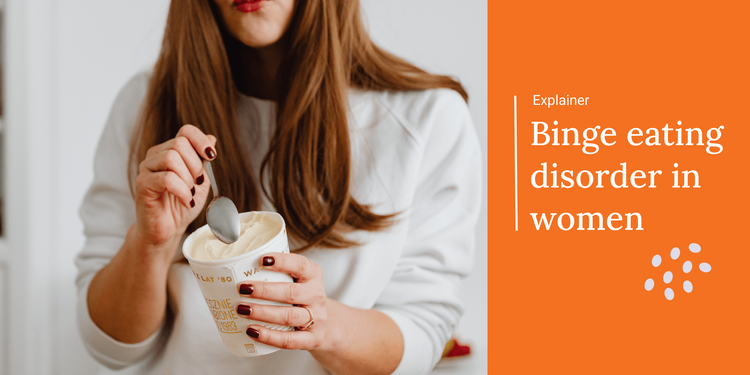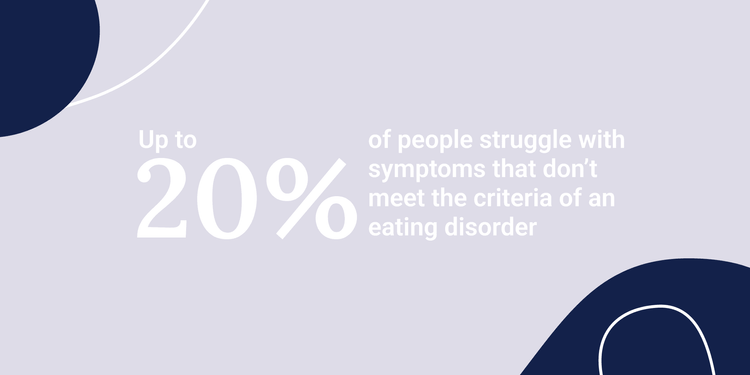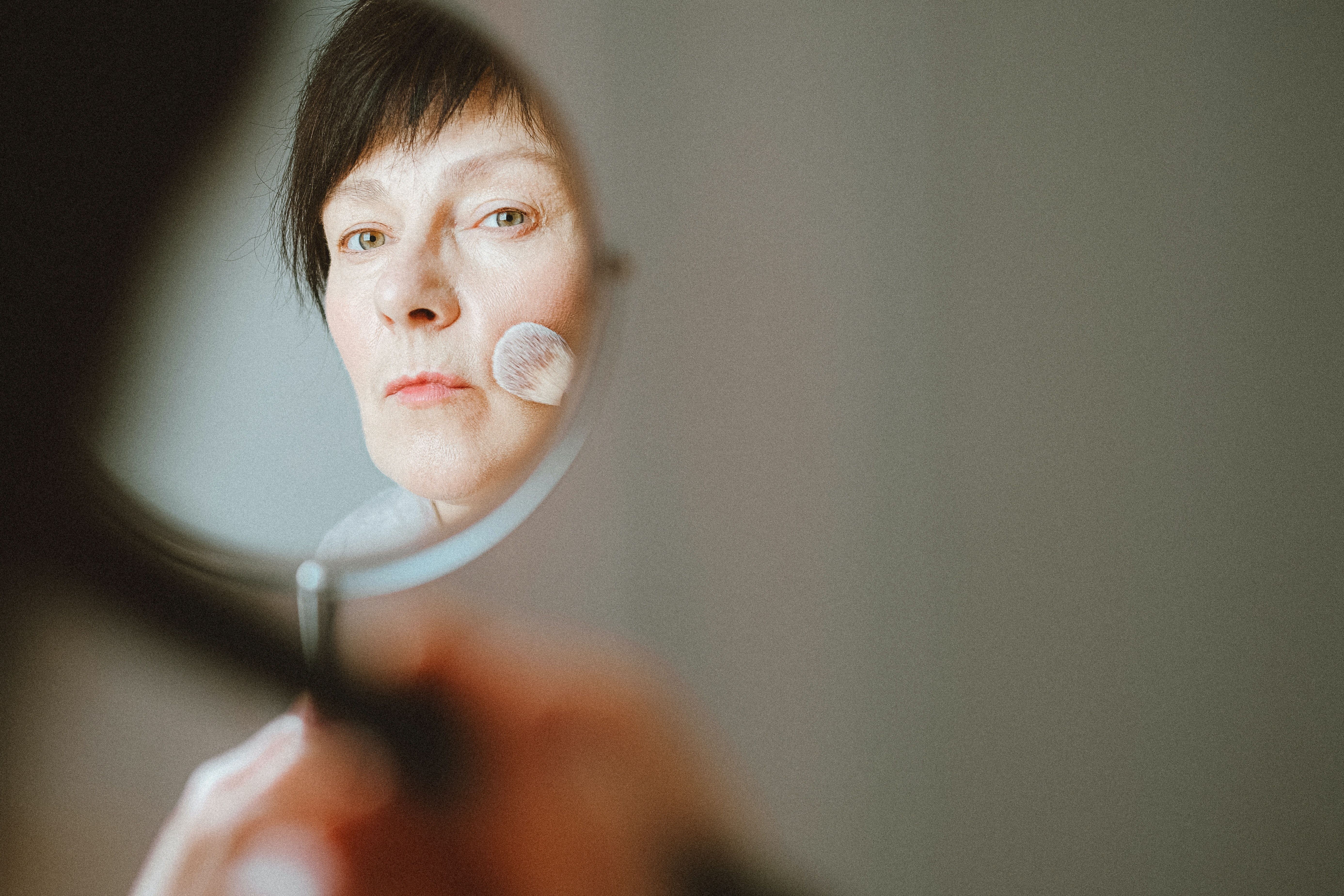
Jun 21, 2023, 4:00 am UTC
8 min
Created by
The Hidden Struggle: Midlife eating disorders are more common than you think
Betsy Brenner wasn't diagnosed with anorexia nervosa until her 40s, but she is far from alone.
While eating disorders typically develop in adolescence or young adulthood, research shows that eating disorders in midlife are surprisingly prevalent, affecting approximately 3.5% of women over 40. In fact, the prevalence of eating disorder symptoms, such as purging, binge eating, strict dieting, or fasting, can be as high as 29.3% among midlife women.
Data also suggests that more women in midlife and beyond are seeking treatment for eating disorders than ever before. They struggle with anorexia, bulimia nervosa, purging disorder, and binge eating disorder.
"Like adolescence and young adulthood, midlife is full of tricky transitions. Unlike earlier in life, however, no one is there to catch you when you fall or to coach you back on your feet. Today women feel pressure to do it all and do it perfectly, constantly multitasking at home, and outside of home, taking care of their children and marriages, their extended families, ill and aging parents, all while trying to maintain an identity of their own," says Brenner, author of "The Longest Match," a memoir about her diagnosis and recovery. She is now a speaker and peer support mentor for other women in midlife with eating disorders.
Similar to Brenner, some individuals in midlife are receiving their first-ever diagnosis, while others have been struggling with an eating disorder since adolescence or early adulthood. There is also a third group that has recovered from an eating disorder, but relapsed in midlife.
Regardless of the trajectory or diagnosis, research also indicates that most women never seek help and remain untreated due to the stigma surrounding eating disorders, fear of judgment, or a lack of recognition that they have a significant problem.
These alarming trends serve as a reminder that eating disorders do not discriminate based on gender, race, ethnicity, or age. They also serve as a wake-up call for healthcare professionals who may lack training in recognizing the signs of eating disorders in older adult patients, often overlooking severe health conditions that are hiding in plain sight.
So, what factors contribute to eating disorders in midlife? Does menopause play a role? Are older women receiving the treatment they need? How can friends and family best support midlife women with eating disorders? And where can these women turn for help?
Most research on eating disorders has overlooked women over 30, making it challenging to provide definitive answers to these questions. However, women like Brenner, psychologists specializing in women's health, and eating disorder researchers are increasingly bringing attention to the problem and filling in the knowledge gaps.

How to spot eating disorders in midlife
Healthcare professionals, friends, and family often overlook eating disorders in older adults because these disorders are unexpected or considered "normal" behaviors in response to aging and associated physical changes, such as weight gain.
"The signs are similar to those in younger people — distance from family and friends, avoiding meals, dieting behaviors, weight loss or gain. What's most different is that we often overlook these signs, not recognizing that midlife eating disorders do exist," says Heidi Dalzell, PsyD, a licensed clinical psychologist practicing in Newtown, Pennsylvania, specializing in eating disorders and trauma.
Furthermore, older adults with eating disorders often go to great lengths to hide their behaviors out of shame or embarrassment about having an eating disorder at their age.
"The older I get the more stigma there is because I should [have] dealt with it by...now," said another.
"I should be dealing with like mid-life crisis or something not an eating disorder at my age...I think that's a big part of the embarrassment too, being at the age I am and having to deal with it," said one participant in a study of women with eating disorders in midlife.
However, spotting the signs and symptoms of an eating disorder is critical — and the sooner, the better. The earlier the intervention, the greater the chances of successful treatment and recovery.
Here are the signs and symptoms to look for:
- dramatic weight fluctuations
- preoccupation with weight, calories, and body size and shape
- strictly avoiding certain foods or categories of foods, such as sugar or carbohydrates
- exercising excessively or compulsively
- skipping meals or eating minute portions at regular mealtimes
- chewing excessively, keeping different foods separate on a plate, or other food rituals
- signs of purging, such as frequent bathroom visits, vomiting sounds or odors, or laxative packaging
- build-up of empty food packaging within short periods

The health consequences of eating disorders in midlife
Eating disorders can be serious conditions with severe health consequences, especially when they go undiagnosed and untreated in midlife. In fact, some evidence suggests that older women with eating disorders experience more severe health consequences and poorer outcomes.
Eating disorders can cause electrolyte and hormone imbalances and metabolic changes that affect every organ in the body, including the brain. For example, cognitive impairment can result from significant weight loss in older adults with eating disorders. If eating disorders are untreated or detected later in life, the risk of complications such as malnutrition, anemia, osteoporosis, and cardiovascular diseases increases significantly. Common but less severe complications related to eating disorders include fatigue, dizziness, bowel and dental problems, hot flashes, and cold intolerance.
Additionally, eating disorders — at any age or life stage — profoundly impact mental health, leading to depression, anxiety, and other psychological problems. Increased depression is prevalent in older adults with eating disorders. Social withdrawal, strained relationships, and a poor quality of life can also stem from eating disorders.
Factors contributing to the development of eating disorders in midlife
There's no single cause of eating disorders in midlife. However, societal pressure, media, and cultural norms that associate beauty and slimness with self-worth may contribute to their rise.
For many women, midlife is also a time of significant stress and transition. They may also experience changes in their personal and professional lives, such as divorce, empty nesting, retirement, the death of a loved one, or caring for aging parents. In addition, physical changes that come with aging, illness, and menopause can cause a significant shift in how women perceive their bodies, compounded by societal pressures to look younger and maintain a particular body shape. These changes may lead to feelings of loss, anxiety, and depression, which can trigger disordered eating behaviors as a coping mechanism. They can also lead to negative body image, pushing women to change how they eat and exercise to take control over or remake their physique.
Research suggests that late-onset eating disorders are more likely triggered by illness, health concerns, or stressful life events, including pregnancy and menopause. In contrast, early onset eating disorders, which develop in adolescence or early adulthood, often stem from family and social stressors, including abuse, criticism about weight, eating, and appearance, and social pressures related to body shape and size. The eating disorder trigger that persists across all ages and stages is dissatisfaction with body image. In fact, a recent study confirmed that weight and shape dissatisfaction were two core symptoms in perimenopausal adults with eating disorders.
Daizel's experience counseling midlife women with eating disorders reflects this complexity.
"Midlife eating disorders arise against the backdrop of limited role models regarding what "real women" look like. Witness Martha Stewart's pose in Sports Illustrated. There is enormous pressure to remain young and attractive," she says. "When you add the stressors associated with midlife, such as role transitions, losses, changes in one's body, this combination of factors can result in women seeking out food for more than fuel."
"What's important here is that it is not a "food disease," rather a factor of our broken worldview about beauty and the toxic messages women receive," says Dalzell.
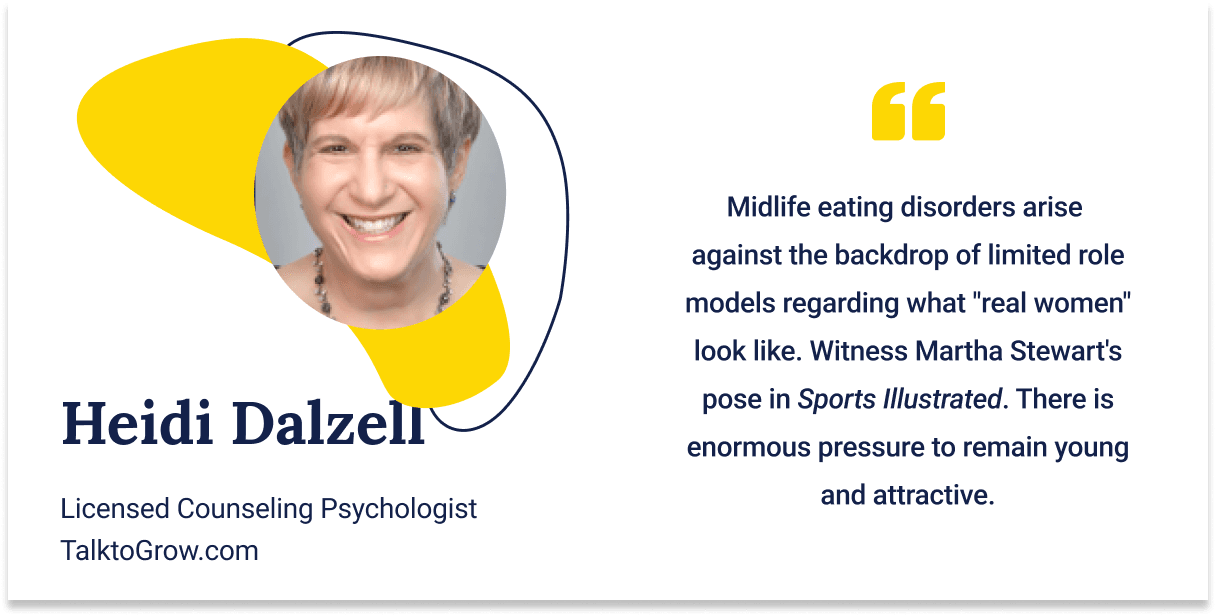
What menopause has to do with eating disorders
While menopause is a normal part of aging, it can also bring about a host of physical and emotional changes that can be difficult to navigate. One of the most significant changes is a shift in body composition. As estrogen and progesterone levels change, women may experience weight gain, particularly in the abdomen. This can be distressing for women who have always maintained a certain body weight or shape.
One recent study found fear of gaining weight and fear of losing control over eating are core symptoms in perimenopausal women with eating disorders, supporting the link between body dissatisfaction and disordered eating.
For women who have a history of disordered eating or body image issues, menopause can be an incredibly challenging time. Hormonal fluctuations can exacerbate existing eating disorders or trigger the development of a new ones. Research has shown that women with a history of anorexia nervosa or bulimia nervosa are at increased risk for relapse during menopause. This may be because menopause can bring a renewed focus on body image and physical appearance.
"Perimenopause is definitely a time of increased risk," says Dalzell.
Women need to be aware of the potential risks and seek support if they struggle with disordered eating or body image issues. This may involve working with a therapist or nutritionist specializing in women's health and menopause, and developing a self-care plan incorporating strategies for managing stress, maintaining a healthy diet, and engaging in regular physical activity.
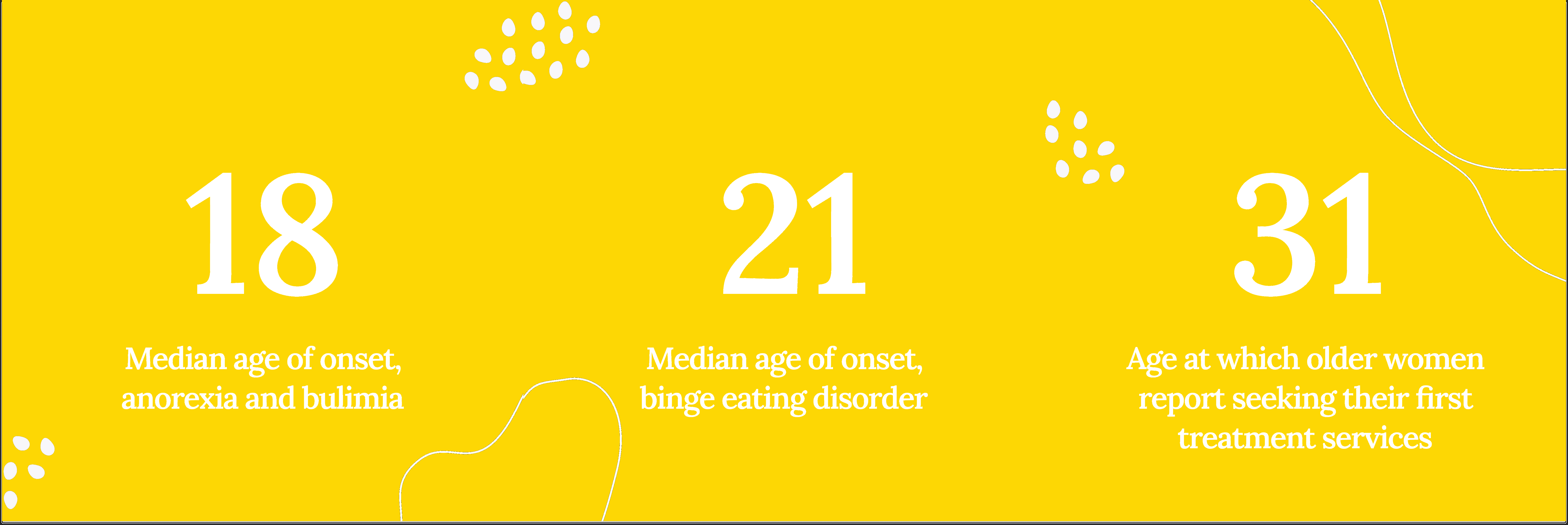
Treating eating disorders in midlife
Treating eating disorders requires a multidisciplinary approach that acknowledges their complexity and addresses their underlying psychological, emotional, behavioral, and physical factors. It usually involves psychological counseling, such as cognitive behavioral therapy, to improve emotional regulation, medical care to address the physical health complications of disordered eating, and nutritional counseling to promote healthy eating. There are very few pharmaceutical treatments for eating disorders. However, medications may be used to manage symptoms like depression or gastrointestinal issues.
Research suggests effective treatment of eating disorders in midlife and older adults is no different. However, older women may face more obstacles to therapy due to personal and professional responsibilities.
However, Dalzell cautions that current treatments often increase, rather than decrease, the stigma associated with eating disorders. "[Treatment programs] are populated by younger clients and do not provide the space to discuss concerns pertinent to midlife. They can also be overly structured, thus not taking into account the collaborative nature of midlife recovery," she says.
Dalzell says she works very differently with midlife and older women in her practice. "They are usually seeking treatment because they want help, and can be active collaborators in the work we do. This leads to the ability to ask them what recovery would mean, and then set individual goals for each," she says.
Supporting loved ones with midlife eating disorders
Support from friends and family can significantly improve the chances of a successful recovery from eating disorders. If you know someone experiencing an eating disorder, be present, supportive, and non-judgmental.
Dalzell says it's vital to support, rather than police, someone with an eating disorder. She recommends finding ways to assist a friend or family member in seeking care by helping with kids or work responsibilities.
"The more concrete the support, the better," she says.
Resources
Awareness about eating disorders in midlife is increasing. Here are some resources to help someone receive a diagnosis, find treatment, and get (and give) support.
- Betsy Brenner's book, "The Longest Match: Rallying to Defeat an Eating Disorder in Mid-Life"
- Talk to Grow: Heidi Dalzell, PsyD, is a woman at midlife and a specialist in eating disorders and trauma who can provide appropriate support to women struggling with eating disorders, body image, and related concerns. She administers a Facebook group specific to midlife eating disorders, including a free support group.
- The Emily Program, an eating disorder treatment center in the U.S., offers a Guide for Families to help mothers, sisters, uncles, friends, neighbors, or anyone else get eating disorder treatment.
- ANAD is a non-profit organization in the U.S. providing peer support services for eating disorders. It offers a free weekly support group for older adults and a free helpline: 1-888-375-7767. ANAD's guidebook, Support at Every Stage, offers information and suggestions for supporting adults with eating disorders.
- National Eating Disorder Information Centre (Canada) runs a helpline, providing 24/7 support at 1-866-NEDIC-20.
Subscribe to our newsletter
Get a weekly roundup of articles, inspiration, and brain health science in your inbox. Subscribe now.
